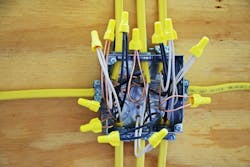The ground-fault circuit interrupter (GFCI) has enjoyed phenomenal success as a life-saving electrical device. Since its introduction in the 1960s, the number of non-utility fatalities has declined markedly.
The GFCI is similar to an overcurrent device in that it interrupts the circuit rather than allowing it to continue operation when a hazardous situation develops. The GFCI continually monitors the circuit, comparing the amount of current (number of electrons flowing in a conductor past a given point per unit of time) in the hot wire going into the load to the amount of current in the neutral wire coming out of the load. These two amounts, in accordance with Kirchhoff’s Current Law, should be the same. If they are not, there is a ground fault in the circuit. If a person, typically grounded, becomes a part of this fault path, the result will be electric shock — which sometimes can be lethal. The GFCI senses this current imbalance and quickly interrupts the circuit, greatly limiting the hazard.
In past cycles, the National Electrical Code (NEC) has continually expanded the number of locations where GFCIs are required — particularly in residential kitchens. The rules for these locations are complex, and there is the possibility for installation errors. Although it is conceivable that a GFCI can be miss-wired, most violations involve failure to install GFCI protection in the first place. Since it is difficult to photograph GFCIs that have not been installed where mandated, this month’s gallery of GFCI images consists of compliant installations rather than those that are in violation of the NEC. Let’s take a look at how to do it right.
RELATED GALLERIES
About the Author
David Herres
Licensed Master Electrician
David Herres is a licensed master electrician in Stewartstown, N.H. He can be reached at [email protected].


